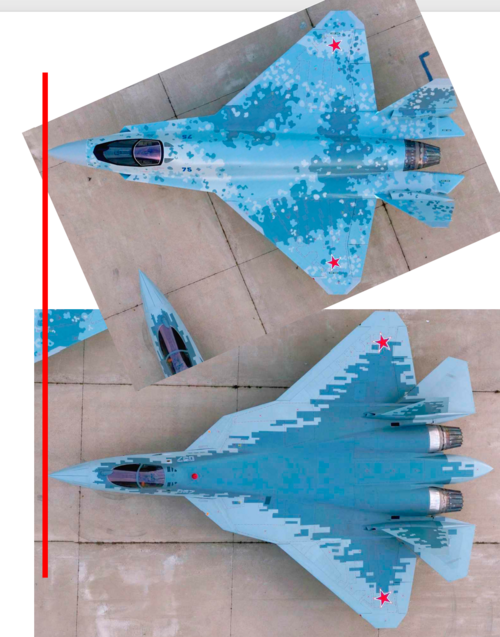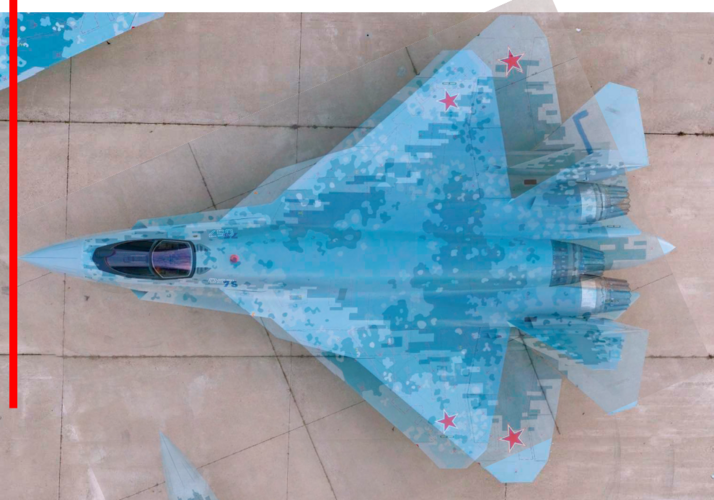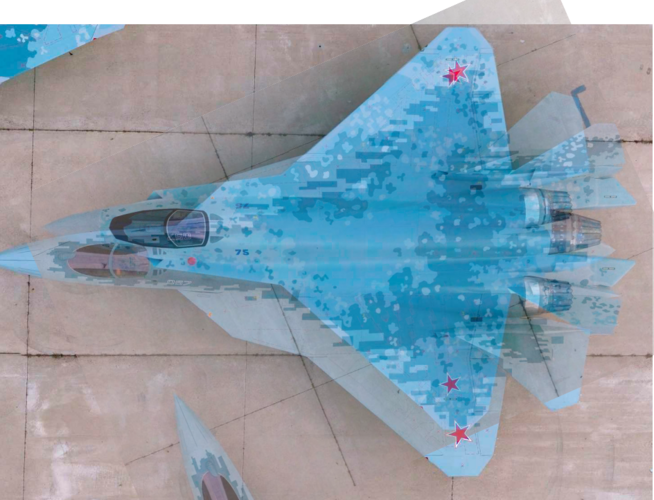- Joined
- 29 November 2010
- Messages
- 1,775
- Reaction score
- 3,479
Nothe Su-75 just has the ability to carry more weapons
Noa better radar
like i said correct me if im wrong.....Nothe Su-75 just has the ability to carry more weapons
Noa better radar
| Byelka | |
|---|---|
| Engaged Aerial Targets | 16 |
| Max Detection Range (kilometer) | 400 |
| T/R Modules | 2,238 |
| Tracked Aerial Targets | 60 |
Pure numbers of carried weight are barely relevant if there is no munitions arragement that fits into said weight. Number of missiles in Su-57 bays is still hanging unconfirmed. And overally it's quite simple: one main bay and two aux, vs two main bays and two aux.the Su-75 has a maximum payload capacity of 7,400 kg with only 5 missiles and an auto-cannon
the Su-57 can carry four beyond-visual-range missiles in its two main weapons bays and two short-range missiles in the side bays.
true that. then again the Su-75 has a few configurations availible (according to Sukhoi)Pure numbers of carried weight are barely relevant if there is no munitions arragement that fits into said weight. Number of missiles in Su-57 bays is still hanging unconfirmed. And overally it's quite simple: one main bay and two aux, vs two main bays and two aux.the Su-75 has a maximum payload capacity of 7,400 kg with only 5 missiles and an auto-cannon
the Su-57 can carry four beyond-visual-range missiles in its two main weapons bays and two short-range missiles in the side bays.
if the internal weapon release mechanisms were modified to do so. i dont see why not. however we still dont have the weapons bay dimensionsIs it possible that this aircraft can be the internal carrier of the Larva-MD missiles?
Is it possible that this aircraft can be the internal carrier of the Larva-MD missiles?
Su-75' main bay has equal dimensions to the Su-57' ones. So, yes, it should be able to carry every single munition adapted for Su-57 main bays.Is it possible that this aircraft can be the internal carrier of the Larva-MD missiles?
thanks for this pictureMaybe this version, i've made without unnecessary elements will be better. Here we can see that 75 is bigger than expected before



I think we were given a hint when during the checkmate release event it said it can carry five A2A missiles internally. The checkmate's underbelly internal bay looks almost identical to the two su-57 internal bays. Their size I think are nearly identical. It is an assumption but I think it is a safe one to say that the su-57 would be able to carry three A2A r-77m in each underbelly bay as well as one r-74m2 in each side bay. So the su-57 most likely (in my opinion) can carry eight A2A missiles internally.Pure numbers of carried weight are barely relevant if there is no munitions arragement that fits into said weight. Number of missiles in Su-57 bays is still hanging unconfirmed. And overally it's quite simple: one main bay and two aux, vs two main bays and two aux.the Su-75 has a maximum payload capacity of 7,400 kg with only 5 missiles and an auto-cannon
the Su-57 can carry four beyond-visual-range missiles in its two main weapons bays and two short-range missiles in the side bays.
Great work! And though the checkmate is indeed large I think you sized it a bit bigger than it actually is. Note the engine nozzle size differences. They should be identical. Note the su-57 prototype/model is sporting izd 30 nozzles! Very cool!thanks for this pictureMaybe this version, i've made without unnecessary elements will be better. Here we can see that 75 is bigger than expected before
here are some quick shops ive made
nose to nose comparison
View attachment 667638
Overlap by nose. The nose is pretty much perfect with each other in size
View attachment 667639
Overlap by wing.. virtually the same
View attachment 667640
Great work! And though the checkmate is indeed large I think you sized it a bit bigger than it actually is. Note the engine nozzle size differences. They should be identical. Note the su-57 prototype/model is sporting izd 30 nozzles! Very cool!thanks for this pictureMaybe this version, i've made without unnecessary elements will be better. Here we can see that 75 is bigger than expected before
here are some quick shops ive made
nose to nose comparison
View attachment 667638
Overlap by nose. The nose is pretty much perfect with each other in size
View attachment 667639
Overlap by wing.. virtually the same
View attachment 667640
Edit: err... I think I am still correct, but I could be wrong as well, not sure.
Quite the opposite actually, except for the single engine... the Su-75 has the same wings of the Su-57 with almost half of the weight and one instead of two main weapon bays. Hence, the wing area of the LTS should be huge for its weight and accordingly the wing loading very, very small, close to that of the Eurocanards or even better. The Su-57 is the big, expensive, high end air superiority fighter, while the LTS is the cheap, simple, single engine tactical aircraft(correct me if im wrong) but the Su-57 has more wing area, more lift and has a better wing-load capacity correct? the Su-75 just has the ability to carry more weapons, a better radar and a single engine. (with the loss of wing area thus increasing the distance/airspeed needed for takeoff/manuevers) however what really changes everything is mostly the targeting designation/priority system
didnt see this post of yours so maybe this article will help you understand that their is a modernization of the Su-57 and the only thing modern or new the Su-75 is getting from the Su-57 are the engines but the newer weapons and avionics are a big unknown, but I am not saying it wont happen since I think the aircraft is to enter production in 2026 supposedly. https://iz.ru/1028035/anton-lavrov-...khim-istrebitel-su-57-ozhidaet-modernizatciiathe Su-75 just has the ability to carry more weapons, a better radar and a single engine. (
i dunno if you take requests but if you do..I should be making my own 3D model of LTS soon.

 su-checkmate.tass.ru
su-checkmate.tass.ru
let me know if there is an english version of that because google page translate sucks
Journos have really tried to do their best, but f***ed it up being few meters from the finish line, by describing F-35 combat radius as its flight range.Как устроен первый российский однодвигательный истребитель - в спецпроекте ТАСС
Лёгкий тактический самолёт (ЛТС) Checkmate (в переводе с англ. — "Шах и мат") — это первый российский однодвигательный истребитель пятого поколенияsu-checkmate.tass.ru
didnt think about weight. looks like one thicc boi next to the Su-57 but its less structural hardware than it looks like. and btw is the frame bonded aluminum? or some other material?Quite the opposite actually, except for the single engine... the Su-75 has the same wings of the Su-57 with almost half of the weight and one instead of two main weapon bays. Hence, the wing area of the LTS should be huge for its weight and accordingly the wing loading very, very small, close to that of the Eurocanards or even better. The Su-57 is the big, expensive, high end air superiority fighter, while the LTS is the cheap, simple, single engine tactical aircraft(correct me if im wrong) but the Su-57 has more wing area, more lift and has a better wing-load capacity correct? the Su-75 just has the ability to carry more weapons, a better radar and a single engine. (with the loss of wing area thus increasing the distance/airspeed needed for takeoff/manuevers) however what really changes everything is mostly the targeting designation/priority system
great job! didnt think of using scale drawings and getting the area that way.... i knew the Su-57 had more surface area. and also aileron/tail area as well. but because of the weight difference. im not sure which one would perform better. i honestly think they are almost equal except because of one engine and less weight that the Su-75 would perform slightly betterWing bearing area:
Su-57 - 82 m2
LTS - 60 m2
It has half the thrust, it cannot weight much more than half of what the Su-57 does. The cross sectional area should be around 6-6.5 sqm vs 10 sqm of the Su-57, so it is not a thick box, that is exactly where the Sukhoi team corrected the shortcomings of the F-35 layout, by placing the main weapon bay in line with the engine and not in parallel. It has a streamlined and relatively long fuselage with little drag and good fineness ratio, so both excess power and supersonic performance should be quite good, even with relatively "unremarkable" engines like the AL-41F1 or F1S. With izd. 30 and its 3 stream derivative, new possibilities will open up.didnt think about weight. looks like one thicc boi next to the Su-57 but its less structural hardware than it looks like. and btw is the frame bonded aluminum? or some other material?
The Su-57 has the same engine class and I don't see a reason why it should not be classified in the same size class of the Flanker, but modern technology has allowed Russia to reduce systems size and make a much more compact airframe.What's interesting is that the PAK FA was originally meant to be a more affordable next-generation fighter program than the MFI, which was absolutely massive in size and required two 18-tonne AL-41Fs. Once it was clear that it would be extremely expensive, rather than continuing with the MFI and LFI combination, the Russian Defense Ministry established that the PAK FA should be an intermediate size multirole fighter that would replace both the MiG-29 (LPFI) and Su-27 (TPFI). In fact, in the 2000s, an oft-repeated statement was that the T-50 would be between the MiG-29 and Su-27 in size, with a normal takeoff weight (presumably internal payload and 50-60% fuel as with the Su-27) of 22-23 tonnes (which has now crept up to 25 tonnes for the production Su-57).
A twin engine fighter with those characteristics would be a medium fighter. LTS is named light by its creators even when it is bigger than a 4G light fighter. I don't think a multirole fighter (that is, with internal bays for A2G ordnance) can be designed with a smaller airframe than LTS. It has the same engine of the Su-57, so despite its apparent big size it represents today's best embodiment of the hi-lo paradigmGiven the history of the PAK FA, it's a bit ironic now because the Sukhoi LTS appears to be about the same size as the Mikoyan E-721 that was rejected in favor of the larger Sukhoi T-50. The E-721 was supposed to have been 16-17 tonnes normal takeoff weight with two 10-11-tonne class Klimov engines, though with what happened to the T-50, the E-721 would probably also have suffered from weight creep.
We do know that Putin endorsed it, and you can bet your money that this is not a crazy adventure by Sukhoi/UAC/Rostec, but a carefully planed initiative. MoD simply does not want to paint themselves into a corner by promising anything before the product is mature enough, but Industry Ministry money will flow in the meantime and Rostec is at the end of the day a state controlled company. Nothing this big happens in Russia without the blessing of the government and covert alignment with MoD.Of course, we still don't know if the Russian Aerospace Forces are actually interested in the LTS, or if it's simply a proposal by Sukhoi hoping to attract their attention. It was a similar approach with the Su-35S (i.e. the T-10BM was a Sukhoi-initiated effort, rather than the Russian Defense Ministry), but that aircraft was eventually adopted. They did reject the similarly-sized E-721, though to be fair, it does appear that politics has as much to do with Mikoyan's rejection as much as the proposal itself; after all, Sukhoi captured the lion's share of exports during the 1990s while Mikoyan largely withered and put resources into the ultimately futile MFI.
Given that the duct diameter isn't much smaller than the engine diameter, and the inlets run over the weapon bays, I wouldn't consider the weapon bay placement to be the predominant factor. The F-35's lower fineness ratio has more to do with the fuselage length, which was limited by the deck lifts of LHAs, combined with extremely high fuel fraction and weapon bays sized for 2,000 lb ordnance. The LTS isn't constrained in this regard, which can allow for a more slender design, although it's also sized for an AL-41F1-sized engine which is considerably smaller than the F135, which actually doesn't make full use of the F-35's inlet flow (flow was increased in 2005 during SDD, and the GE/RR F136 would have made full use of it).It has half the thrust, it cannot weight much more than half of what the Su-57 does. The cross sectional area should be around 6-6.5 sqm vs 10 sqm of the Su-57, so it is not a thick box, that is exactly where the Sukhoi team corrected the shortcomings of the F-35 layout, by placing the main weapon bay in line with the engine and not in parallel. It has a streamlined and relatively long fuselage with little drag and good fineness ratio, so both excess power and supersonic performance should be quite good, even with relatively "unremarkable" engines like the AL-41F1 or F1S. With izd. 30 and its 3 stream derivative, new possibilities will open up.
The Su-57 is intermediate size compared to what the original heavyweight fifth generation fighter, the MFI, was supposed to be. It's a similar situation where the F-35 is considered to be the "light" fighter compared to the F-22, yet the F-35A's empty weight is similar to the F-15C's.The Su-57 has the same engine class and I don't see a reason why it should not be classified in the same size class of the Flanker, but modern technology has allowed Russia to reduce systems size and make a much more compact airframe.
...
A twin engine fighter with those characteristics would be a medium fighter. LTS is named light by its creators even when it is bigger than a 4G light fighter. I don't think a multirole fighter (that is, with internal bays for A2G ordnance) can be designed with a smaller airframe than LTS. It has the same engine of the Su-57, so despite its apparent big size it represents today's best embodiment of the hi-lo paradigm
The Su-35 was originally a Sukhoi-initiated effort meant for export, but after struggling to find export customers, the Russian Defense Ministry decided to procure it. I'm not calling it a "crazy adventure", but simply that the impetus didn't come from the Defense Ministry, similar to the case with the Su-35. Not that it's necessarily a bad thing.We do know that Putin endorsed it, and you can bet your money that this is not a crazy adventure by Sukhoi/UAC/Rostec, but a carefully planed initiative. MoD simply does not want to paint themselves into a corner by promising anything before the product is mature enough, but Industry Ministry money will flow in the meantime and Rostec is at the end of the day a state controlled company. Nothing this big happens in Russia without the blessing of the government and covert alignment with MoD.
The duct is a flexible shape, while the engine is not. It is smaller in diameter, and has no ancillaries or need to provide access for maintenance and exchange as the engine does. I did the effort of checking layouts in 3D and came to a design basically identical to the LTS, there is no way of achieving such slender fuselage and reduced cross section with weapon bays parallel to the engine, it simply does not work, by a wide margin. Much less if the engine is as big as the F135.Given that the duct diameter isn't much smaller than the engine diameter, and the inlets run over the weapon bays, I wouldn't consider the weapon bay placement to be the factor. The F-35's lower fineness ratio has more to do with the fuselage length, which was limited by the deck lifts of LHAs, combined with the very high fuel fraction and weapon bays sized for 2,000 lb ordnance. The LTS isn't constrained in this regard, which can allow for a more slender design, although it's also sized for an AL-41F1-sized engine which is considerably smaller than the F135, which actually doesn't make full use of the F-35's inlet flow (inlet flow was increased in 2005 during SDD, and the F136 would have made full use of it).
And yet the capacities are not worse, well, maybe the top speed, but not payload or range, as far as I know. The progress in systems technology allowed them to do pretty much the same with a smaller airframe. By the beginning of XXI century, the MFI concept had already been surpassed in so many ways it needed replacement.The Su-57 is intermediate size compared to what the original heavyweight fifth generation fighter, the MFI, was supposed to be.
Yes, the weight and size creep from 4th to 5th gen makes it necessary to re-evaluate what a light fighter is. I would say the challenge after the F-35 was to proof that a "light" fighter could be designed around the same engine of the "heavy" brother. And that is a tough challenge, once we see that the LTS with current engines can only afford an 8g airframe with no internal cannon to keep its TWR up there with the best. Most other manufacturers had to settle for a twin engine 5G fighter, only Lockheed could afford a single engine design thanks to a monster engine like the F135, and still they could not keep it the size of the F119.It's a similar situation where the F-35 is considered to be the "light" fighter compared to the F-22, yet the F-35A's empty weight is similar to the F-15C's.
Yeah, MoD allow themselves to be convinced by the industry quite often. In the case of the Su-35, the reason was also the need to bridge the 4th - 5th gen gap. This was also needed for the VKS, hence why I doubt also in this case, that there was not a basic common understanding between MoD and MIC about the expediency of making the effort of designing and fielding an almost new plane. For VKS it had the additional advantage of providing a very much needed B plan in case the PAK-FA program suffered delays and setbacks, as any complex program normally does. Come 2018, Borisov could afford to bluff that they had no problem buying further the Su-35 and shortly thereafter we had the news of a 76 units deal for the Su-57 with 20% price reduction from the original quotes. This leverage would not have been there without the Su-35...The Su-35 was originally a Sukhoi-initiated effort meant for export, but after struggling to find export customers, the Russian Defense Ministry decided to procure it. I'm not calling it a "crazy adventure", but simply that the impetus didn't come from the Defense Ministry, similar to the case with the Su-35. Not that it's necessarily a bad thing.
